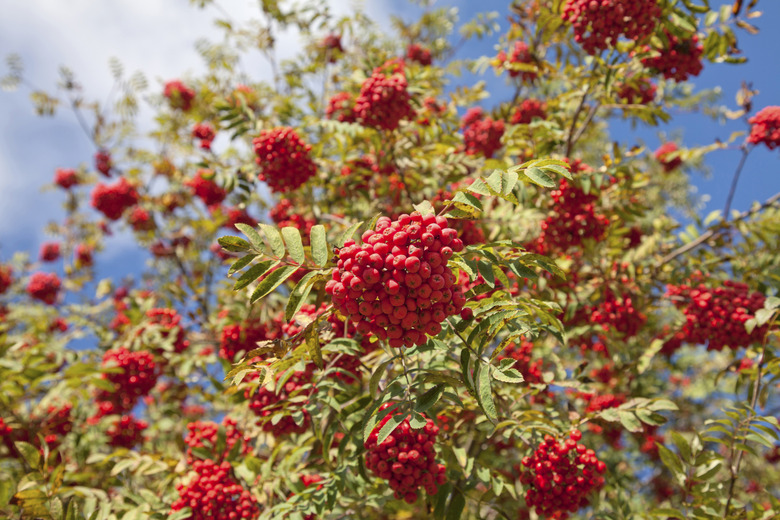The Name Of The Tree With Orange Berries
Although numerous decorative shrubs yield orange berries, few trees do. A plant should have a trunk at least 3 inches wide and be at least 13 feet tall at maturity to qualify as a tree. Three U.S. native trees plus an import from Australia produce orange berries. The berries or seeds of these trees typically attract birds and other wildlife, but some are toxic to humans.
Ash Species
Two ash tree species native to the United States have orange berries. They are American mountain ash (Sorbus Americana) and northern mountain ash (Sorbus decora). American mountain ash, a deciduous ornamental tree, typically grows 15 to 20 feet tall but may grow as high as 30 feet. Its leaves are on bright-red stalks and turn golden orange in autumn. Its orange to red berries contain tannin so should be consumed only in moderation, and its seeds, which are in the berries, are reportedly poisonous to humans. American mountain ash grows best in cool, moist, acidic soil and is hardy in U.S. Department of Agriculture plant hardiness zones 2 through 7. Also deciduous, northern mountain ash grows 25 to 50 feet tall. Its blue-green foliage turns yellow-orange to reddish-purple in autumn. Its clusters of white blossoms yield drooping clusters of orange to red berries, and its berries' seeds are toxic and may be fatal if eaten by children. Northern mountain ash thrives in moist soil and shade to partial shade. It is hardy in USDA zones 2 through 9.
- Although numerous decorative shrubs yield orange berries, few trees do.
- Its orange to red berries contain tannin so should be consumed only in moderation, and its seeds, which are in the berries, are reportedly poisonous to humans.
Netleaf Hackberry
Although ash tree species that yield orange berries require moist soil, another tree with similar berries evolved in arid areas of the U.S. Southwest and northern Mexico. That tree is the netleaf hackberry (Celtis reticulata). It grows 20 to 30 feet tall and has leaves that are light green on the bottom and dark green on top. Its pea-size berries turn from green to orange or red in late summer or early autumn and are eaten by birds. Netleaf hackberry specimens in plant nurseries are deceptive because they do not yet display the rough-textured, gnarled appearance they will have when mature. Netleaf hackberry is hardy in USDA zones 6 through 9.
Victorian Box
Native to Australia, the evergreen Victorian box tree (Pittosporum undulatum), grows 24 to 36 inches each year, reaching 35 feet high. It requires moist to wet, slightly acidic to alkaline soil and is hardy in USDA zones 9 through 10. Victorian box has dark-green leaves, and its showy white, springtime flowers give way to 1/4- to 1/2-inch-wide, yellow or orange fruit capsules in autumn. The tree can be invasive; removing unwanted seedlings can prevent that problem.
- Although ash tree species that yield orange berries require moist soil, another tree with similar berries evolved in arid areas of the U.S. Southwest and northern Mexico.
- Native to Australia, the evergreen Victorian box tree (Pittosporum undulatum), grows 24 to 36 inches each year, reaching 35 feet high.
Poison Alert
Even though you may see birds and other wildlife eating the berries of these and other trees, that does not mean they are free of substances that are toxic to humans, especially children. If anybody has an upset stomach, nausea, sweating or other symptoms of poisoning after eating any berries, either contact a physician or call the national poison control hotline at 1-800-222-1222.
References
- Lady Bird Johnson Wildflower Center: Sorbus Americana
- ZipcodeZoo.com: Sorbus Americana
- Lady Bird Johnson Wildflower Center: Sorbus Decora
- ZipcodeZoo.com: Sorbus Decora
- ZipcodeZoo.com: Celtis Reticulata
- California Polytechnic State University, Urban Forest Ecosystems Institute: Victorian Box, Pittosporum Undulatum
- Floridata: Pyracantha Coccinea
- MedlinePlus, National Institutes of Health: Poison Control Center – Emergency Number
